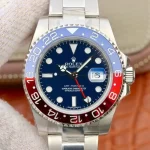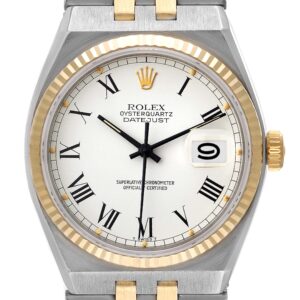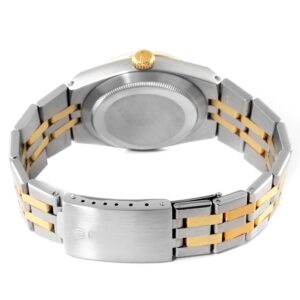
When you catch sight of the fluted bezel and winding crown adorning a luxury watch, chances are it’s a Rolex nestled within that rugged stainless-steel casing. This iconic aesthetic traces its origins back to 1926 when Rolex introduced a groundbreaking new case design known as the Oyster. Prior to this innovation, watches and their intricate mechanical workings were highly vulnerable to dust, moisture, and pressure. However, the revolutionary Oyster case, crafted by the iconic Rolex brand, provided a solution, encasing the watch within an airtight fortress capable of withstanding the rigors of everyday wear and tear. 
This pioneering creation transformed the landscape of watchmaking. While waterproof designs had existed before, they often fell short in effectively keeping water out or necessitated cumbersome handling akin to a small clock to maintain their integrity. With the Oyster case’s threaded back and screwed-down winding crown, Rolex perfected the formula for true water and dust resistance. This breakthrough enabled their replica watches to accompany deep-sea divers, motorsport drivers, polar explorers, and everyday wearers alike, without the risk of damage.
Over the course of nearly a century, Rolex continued to refine and enhance the Oyster case through relentless experimentation and testing, spanning from high altitudes to the deepest ocean trenches. Even as new Rolex watch families emerged, the resilient Oyster case remained a constant presence, whether gracing a classic Submariner model or a cutting-edge Yacht-Master. Across generations, this iconic casing ensures the longevity of both replica Rolex watches and their storied legacy.
After more than two years of meticulous planning and testing, Rolex unveiled the first iteration of the Oyster case in 1926, featuring a revolutionary hermetic seal design. This initial version boasted a smaller 33 mm case crafted from 21K gold, equipped with a newly patented screw-down winding crown, threaded screw-down fluted bezel, and screw-down caseback. This innovative construction created a sealed vacuum within the case, effectively shielding the mechanical movement from dust and moisture. Rolex showcased the ingenuity of its threaded sides concept, which tightly compressed the caseback, case body, winding crown, and crystal together, reminiscent of an oyster shell, hence the name.
In 1927, Rolex introduced the 35 mm Rolex Oyster, featuring its first in-house self-winding movement alongside the pioneering Oyster case. Subsequent years saw Rolex further refining their designs, introducing patented dust cover caps that could be unscrewed to allow the crown to be wound without compromising the case’s integrity. By 1931, Rolex achieved another milestone by integrating their self-winding system with the Oyster case, resulting in the creation of the first self-winding and waterproof wristwatch: the Rolex Oyster Perpetual. This groundbreaking model, with its hermetically sealed Oyster case, could be continuously wound by the wearer’s wrist motion while effectively keeping water and debris at bay. These early Oyster models sparked a revolution and laid the foundation for Rolex’s iconic dive watches.
In October 1927, Rolex conducted a remarkable real-world demonstration of the purported waterproof capabilities of the Oyster case. Renowned British swimmer Mercedes Gleitze wore a Rolex Oyster around her neck for over 10 hours as she became the first British woman to swim across the challenging and frigid English Channel. Despite the grueling 21-mile journey across tumultuous waters, which ultimately forced Gleitze to abandon the swim just 3 miles from completion due to extreme exhaustion, the Oyster housing her cherished Rolex watch emerged unscathed and in flawless working order. This feat garnered widespread attention and instilled immense confidence in Rolex’s new water-resistant case technology, showcasing its ability to withstand prolonged submersion and emerge unharmed.
Several days later, Gleitze successfully completed her swim, becoming the first British female Channel swimmer on her second attempt. Her remarkable feat, coupled with the resilience of the Oyster case, solidified its early triumph. This demonstration of the case’s protection under extreme conditions, along with Rolex’s subsequent introduction of self-winding capabilities, fueled the legend of the Oyster for decades to come.

Throughout the 1930s, Rolex focused on enhancing the Oyster case’s credentials for withstanding water pressure at greater depths, collaborating with explorers, naval officers, and elite divers to conduct real-world trials across the world’s oceans. Feedback from submarine crews and early scuba divers necessitated continual improvements, leading to the release of updated Oyster models equipped with features such as thicker casebacks and patented expanding case back ribs to handle intense water pressure. By the 1940s, Rolex Oysters were relied upon by British Royal Navy divers during World War II operations.
In the 1950s, Rolex introduced the Submariner, a watch specifically engineered to meet the demands of diving. Featuring an oversized winding crown and trademark round Oyster case proportions, the Submariner boasted waterproof capabilities up to 330 feet, along with a rotating timing bezel, establishing it as the benchmark for modern clone watches. Whether enduring record dives or routine saturation plunges, the Oyster continued to refine its submarine prowess at increasingly greater depths. By 1967, Rolex introduced the legendary Sea-Dweller model, waterproof up to 1500 feet, equipped with a patented helium escape valve designed specifically for experimental deep-sea dives.
By the 1970s, the fundamental architecture of the Oyster had stood the test of time, with Rolex largely settling on core case proportions, such as the 40mm diameter found in the Rolex Submariner and replica Rolex GMT Master models, along with trademark features like the cyclops magnification lens and rotating bezels. Despite unveiling novel technologies such as ceramic bezels and dive bracelets, the essence of the original 1926 Oyster remained intact, safeguarding Rolex’s signature Calibers within its fortress-like stainless-steel casing.
In subsequent decades, Rolex diversified the Oyster design, introducing specialized models tailored to the demands of sailing, such as the robust 44mm Yacht-Master debuted in 1992. Featuring an overbuilt case with bulky shoulders and crown guards, the Yacht-Master was designed to withstand the rigors of sea spray, temperature shifts, and accidental impacts, while retaining the functional elegance synonymous with the Oyster hallmark. By 2000, Rolex had upgraded all Oyster cases to utilize harder 904L steel, further enhancing resilience against wear and tear, particularly crucial for its prized Daytona chronographs.

While the Oyster may not always steal the spotlight from more overt status symbols like the Presidential bracelet or fluted bezel, Rolex continues to perfect its proportions. From the 1990s into models such as the recent 2020 Oyster Perpetual 41, Rolex Oyster cases subtly adhere to the “golden ratio,” with elegant spacing between lugs, bezels, winding crowns, and pushers. This mathematically pleasing harmony complements the bold utilitarianism that has cemented the Oyster as a pinnacle of industrial art.
After a century of safeguarding Rolex movements, the Oyster exemplifies how unwavering dedication to precision engineering yields timeless distinction. Its design serves as a private sanctuary for the delicate craft of watchmaking, while enabling humanity’s thirst for adventure in the most extreme environments on earth.